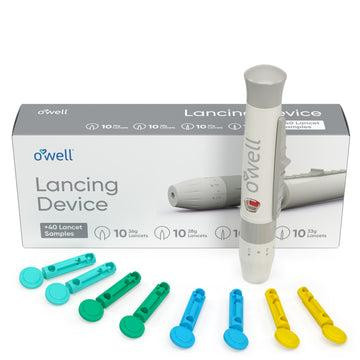For individuals living with diabetes, regular blood glucose monitoring is a crucial part of managing their condition. Lancets and lancing devices are essential tools in this process, allowing for efficient and virtually painless blood sampling. In this comprehensive guide, we will explore everything you need to know about lancets, lancing devices, and how to make blood glucose monitoring a seamless part of your daily routine.
What are Lancets and Lancing Devices?
Lancets: Lancets are small, sharp, and disposable needles designed to prick the skin and draw a small drop of blood for glucose testing. They are typically very thin, minimizing discomfort during the process. Lancets are available in various gauges, with smaller gauges (such as 30G) being thinner and causing less pain. Lancets are sterile and come in individual packaging to ensure safety and hygiene.
Lancing Devices: Lancing devices, also known as lancet devices or blood lancet devices, are handheld instruments used to hold and control the depth of a lancet's penetration into the skin. They are designed to make blood sampling quick, precise, and minimally painful. Lancing devices are adjustable, allowing you to select the depth of the lancet's penetration to match your skin type and testing needs.
Why are Lancets and Lancing Devices Used?
Lancets and lancing devices are an integral part of blood glucose monitoring for individuals with diabetes. Here's why they are essential:
Regular Monitoring: People with diabetes need to monitor their blood glucose levels regularly to ensure they are within the target range. This information helps them make informed decisions about medication, diet, and lifestyle.
Treatment Adjustments: Blood glucose readings guide adjustments to insulin doses, medication, and dietary choices. Monitoring allows individuals to fine-tune their treatment plans for better diabetes management.
Detecting Hypoglycemia and Hyperglycemia: Monitoring helps identify episodes of low blood sugar (hypoglycemia) and high blood sugar (hyperglycemia) promptly, allowing for timely interventions to prevent complications.
Tracking Trends: Consistent monitoring enables individuals to observe patterns and trends in their blood glucose levels, which can inform long-term diabetes management strategies.
How to Use Lancets and Lancing Devices: Step-by-Step Guide
Gather Your Supplies: Before you begin, gather the necessary supplies, including your lancing device, lancets, alcohol wipes, a glucose meter, and test strips.
Wash Your Hands: Clean your hands thoroughly with soap and water or use an alcohol wipe to ensure that your fingers are free from dirt and contaminants.
Prepare the Lancing Device: Load a fresh lancet into your lancing device. Most lancing devices have a cap that you can remove to expose the lancet. Insert the lancet firmly into the device, ensuring it's secure.
Adjust the Depth: Many lancing devices allow you to adjust the depth of the lancet penetration. Start with a shallow setting and adjust as needed based on your comfort and skin type.
Choose a Site: Decide where you will perform the blood glucose test. Common testing sites include the sides of your fingertip, but other sites like the palm or forearm can also be used.
Clean the Site: Wipe the chosen testing site with an alcohol wipe and allow it to air dry. This step ensures that the area is free from contaminants that could affect the accuracy of the reading.
Lance Your Skin: Position the lancing device against the clean site and press the release button or trigger. The lancet will quickly prick your skin, creating a small blood drop.
Collect the Blood Sample: Gently squeeze the area around the lanced spot to encourage the blood drop to form. Ensure you have a sufficient amount of blood for your glucose meter.
Apply the Blood to the Test Strip: Touch the tip of the test strip to the blood drop, allowing it to be drawn into the strip. Follow the instructions on your glucose meter to complete the testing process.
Dispose of the Lancet Safely: After use, carefully remove the lancet from the lancing device (if necessary) and dispose of it in a designated sharps container. Do not recap or reuse lancets to prevent accidental needlesticks.
Record Your Results: Record your blood glucose reading in a logbook, app, or electronic device to track your progress and share the information with your healthcare provider.
Tips for Comfortable and Efficient Blood Glucose Monitoring
Rotate Testing Sites: Avoid testing in the same spot repeatedly to minimize discomfort and prevent calluses or bruising.
Warm Your Hands: Warming your hands before testing can help increase blood flow to your fingertips, making it easier to obtain a blood sample.
Use a New Lancet: Always use a fresh lancet for each testing session to ensure a sharp and painless puncture.
Choose the Right Lancet Gauge: Opt for a lancet gauge that balances the need for an adequate blood sample with minimal pain. Consult your healthcare provider for recommendations.
Follow Your Healthcare Provider's Guidance: Your healthcare provider can provide personalized guidance on how often to monitor your blood glucose and what your target range should be.
For More Info:-
sexual wellness centers of texas







Comments